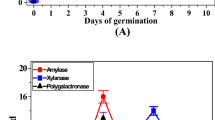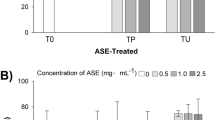Abstract
Suitability assessment of amaranth sprouts as a new functional food was carried out. The optimisation of sprouting process and the influence of selenium supplementation, in doses 10, 15, and 30 mg/l of selenium as sodium selenite, on amaranth growth and fatty acid profile were examined. Methods such as FRAP, DPPH, polyphenols content and GPX activity were applied to characterize antioxidant potential of seeds and sprouts of four different edible amaranth genera. E. coli, S. aureus, C. albicans were used to evaluate amaranth sprouts antimicrobial properties. Interaction between amaranth sprouts and biological systems was assessed by analysing antibacterial and antifungal properties with a disc diffusion test. The studies proved amaranth sprouts to be potentially attractive as functional food. As confirmed by all the data amaranth sprouts are suitable as a moderate selenium accumulator and are rich in essential fatty acids, especially linoleic and alpha-linolenic acids, which are precursors of long chain polyunsaturated fatty acids. Thus, it opens dietary opportunities for amaranth sprouts. They can also serve as a moderate source of antioxidant compounds. Nevertheless, the experiments revealed neither antibacterial, nor antifungal properties of sprouts. In general, amaranth sprouts biological activity under evaluation has failed to prove to be significantly impacted by selenium fertilization.





Similar content being viewed by others
References
Benzie IF, Strain JJ (1996) The ferric reducing ability of plasma (FRAP) as a measure of “antioxidant power”: the FRAP assay. Anal Biochem 239(1):70–76
Berti C, Riso P, Brusamolino A, Porrini M (2005) Effect on appetite control of minor cereal and pseudocereal products. Br J Nutr 94:850–858
Carlson CL, Kaplan DI, Adriano DC (1989) Effects of selenium on germination and radicle elongation of selected agronomic species. Environ Exp Bot 2:493–498
Cartes P, Gianfreda L, Mora ML (2005) Uptake of selenium and its antioxidant activity in ryegrass when applied as selenate and selenite forms. Plant Soil 276(1–2):359–367
Chinrasri O, Chantiratikul P, Thosakham W, Atiwetin P, Chumpawadee S, Saenthaweesuk S, Chantiratikul A (2009) Effect of selenium-enriched bean sprout and other selenium sources on productivity and selenium concentration in eggs of laying hens. Asian-Aust J Anim Sci 12:1661–1666
Chung TY, Nwokolo EN, Sim JS (1989) Compositional and digestibility changes in sprouted barley and canola seeds. Plant Foods Hum Nutr 39:267–278
Dávalos A, Gómez-Cordovés C, Bartolomé B (2003) Commercial dietary antioxidant supplements assayed for their antioxidant activity by different methodologies. J Agric Food Chem 51:2512–2519
Djanaguiraman M, Devi DD, Shanker AK, Sheeba JA, Bangarusamy U (2005) Selenium – an antioxidative protectant in soybean during senescence. Plant Soil 272:77–86
Dumont E, Vanhaecke F, Cornelis R (2006) Selenium speciation from food source to metabolites: a critical review. Anal Bioanal Chem 385(7):1304–1323
Everette JD, Bryant QM, Green AM, Abbey YA, Wangila GW, Walker RB (2010) Thorough study of reactivity of various compound classes toward the Folin − Ciocalteu reagent. J Agric Food Chem 58(14):8139–8144
Fernando T, Bean G (1985) A comparison of the fatty acids and sterols of seeds of weedy and vegetable species of Amaranthus spp. J Am Oil Chem Soc 6:89–91
Finley JW, Sigrid-Keck A, Robbins RJ, Hintze KJ (2005) Selenium enrichment of broccoli: Interactions between selenium and secondary plant compounds. J Nutr 135:1236–1238
Folch J, Lees M, Stanley GH (1957) A simple method for the isolation and purification of total lipids from animal tissues. J Biol Chem 226:497–509
Gorinstein S, Vargas O, Jaramillo N, Salas I, Ayala A, Arancibia-Avila P, Toledo F, Katrich E, Trakhtenberg S (2007) The total polyphenols and the antioxidant potentials of some selected cereals and pseudocereals. Eur Food Res Technol 22:321–328
Halvorsen BL, Holte K, Myhrstad MC, Barikmo I, Hvattum E, Remberg SF, Wold AB, Haffner K, Baugerød H, Andersen LF, Moskaug Ø, Jacobs DR Jr, Blomhoff R (2002) A systematic screening of total antioxidants in dietary plants. J Nutr 13:461–471
He HP, Corke H (2003) Oil and squalene in amaranthus grain and leaf. J Agric Food Chem 51:7913–7920
Jahaniaval F, Kakuda Y, Marcone MF (2000) Fatty acid and triacylglycerol compositions of seed oils of five Amaranthus accessions and their comparison to other oils. J Am Oil Chem Soc 77:847–852
Kápolina E, Shah M, Caruso JA, Fedor P (2007) Selenium speciation studies in Se-enriched chives (Allium schoenoprasum) by HPLC–ICP-MS. Food Chem 101:1398–1406
Kumar S, Bagchi GD, Darokar MP (1997) Antibacterial activity observed in the seeds of some Coprophilous plants. Pharm Biol 35:179–184
Lintschinger J, Fuchs N, Moser J, Kuehnelt D, Goessler W (2000) Selenium-enriched sprouts. A raw material for fortified cereal-based diets. J Agric Food Chem 48:5362–5368
Liu L, Howe P, Zhou YF, Hocart C, Zhang R (2002) Fatty acid profiles of leaves of nine edible wild plants: an Australian study. J Food Lipids 9(1):65–71
Maiyo ZC, Ngure RM, Matasyoh JC, Chepkorir R (2010) Phytochemical constituents and antimicrobial activity of leaf extracts of three Amaranthus plant species. Afr J Biotechnol 9:3178–3182
Márton M, Mándoki Z, Csapó-Kiss Z, Csapó J (2010) The role of sprouts in human nutrition. A review. Acta Univ Sapientiae Alimentaria 3:81–117
Mosovska S, Birosova L (2012) Antimycotic and antifungal activities of amaranth and buckwheat extracts. Asian J Plant Sci 11:160–162
Nowak J, Kaklewski K, Ligocki M (2004) Influence of selenium on oxidoreductive enzymes activity in soil and in plants. Soil Biol Biochem 36(10):1553–1558
Nsimba RY, Kikuzaki H, Yotaro K (2008) Antioxidant activity of various extracts and fractions of Chenopodium quinoa and Amaranthus spp. seeds. Food Chem 106:760–766
Orhan I, Özçelik B, Kartal M, Aslan S, Ener B, Özgüven M (2007) Quantification of daidzein, genistein and fatty acids in soybeans and soy sprouts, and some bioactivity studies. Acta Biol Cracov 49(2):61–68
Paśko P, Sajewicz M, Gorinstein S, Zachwieja Z (2008) Analysis of selected phenolic acids and flavonoids in Amaranthus cruentus and Chenopodium quinoa seeds and sprouts by HPLC. Acta Chromatogr 20:661–672
Paśko P, Bartoń H, Zagrodzki P, Gorinstein S, Fołta M, Zachwieja Z (2009) Anthocyanins, total polyphenols and antioxidant activity in amaranth and quinoa seeds and sprouts during their growth. Food Chem 115:994–998
Paśko P, Barton H, Zagrodzki P, Gorinstein S (2011a) Effect of amaranth seeds (Amaranthus cruentus) in deit on some biochemical parameters and essential trace elements in blood of high fructose – fed rats. Nat Prod Res 25:844–849
Paśko P, Bartoń H, Zagrodzki P, Chłopicka J, Iżewska A, Gawlik M, Gawlik M, Gorinstein S (2011b) Effect of amaranth seeds in diet on oxidative status in plasma and selected tissues of high fructose – fed rats. Food Chem 126:85–90
Pedrero Z, Madrid Y, Camára C (2006) Selenium species bioaccessibility in enriched radish (Raphanus sativus): A potential dietary source of selenium. J Agric Food Chem 54:2412–2417
Pyrzynska K (2009) Selenium speciation in enriched vegetables. Food Chem 114(4):1183–1191
Ryan E, Galvin K, O’Connor TP, Maguire AR, O’Brien NM (2007) Phytosterol, squalene, tocopherol content and fatty acid profile of selected seeds, grains, and legumes. Plant Foods Hum Nutr 62:85–91
Seppänen M, Turakainen M, Hartikainen H (2003) Selenium effects on oxidative stress in potato. Plant Sci 165(2):311–319
Sirichakwal PP, Puwastien P, Polngam J, Kongkachuichai R (2005) Selenium content of Thai foods. J Food Comp Anal 18:47–59
Stibilj V, Kreft I, Smrkolj P, Osvald J (2004) Enhanced selenium content in buckwheat (Fagopyrum esculentum Moench) and pumpkin (Cucurbita pepo L.) seeds by foliar fertilisation. Eur Food Res Technol 219:142–144
Szlósarczyk M, Piech W, Paśko P, Opoka W, Krzek J (2011) Voltammetric determination of zinc, copper and selenium in selected raw plant material. Anal Lett 44:1–10
Terry N, Zayed AM, de Souza MP, Tarun AS (2000) Selenium in higher plants. Annu Rev Plant Physiol Plant Mol Biol 51:401–432
Xue T, Hartikainen H (2000) Association of antioxidative enzymes with the synergistic effect of selenium and UV irradiation in enhancing plant growth. Agric Food Sci Finl 9(2):177–186
Xue T, Hartikainen H, Piironen V (2001) Antioxidative and growth-promoting effect of selenium on senescing lettuce. Plant Soil 237:55–61
Zagrodzki P, Joniec A, Gawlik M, Gawlik M, Krośniak M, Fołta M, Bartoń H, Paśko P, Chłopicka J, Zachwieja Z (2007) High fructose model of oxidative stress and metabolic disturbances in rats. Part I. Antioxidant status of rats’ tissues. Bull Vet Inst Pulawy 51:407–412
Zayed A, Lytle CM, Terry N (1998) Accumulation and volatilization of different chemical species of selenium by plants. Planta 206(2):284–292
Acknowledgments
This work was supported in parts by grants from the Polish Ministry of Science and Higher Education, project K/DSC/000805, K/DSC/001960 and K/ZDS/001294. This fatty analysis project was executable through the support given by National Science Centre, Poland DEC-2011/01/B/NZ7/00038. Excellent technical assistance of E. Gajdzik is highly appreciated.
Conflict of interest
The Authors have no conflict of interest to declare.
Author information
Authors and Affiliations
Corresponding author
Additional information
The preliminary results from this paper were presented on the Sixth International Symposium of the European Amaranth Association in Slovakia 2012.
Rights and permissions
About this article
Cite this article
Pasko, P., Gdula-Argasinska, J., Podporska-Carroll, J. et al. Influence of selenium supplementation on fatty acids profile and biological activity of four edible amaranth sprouts as new kind of functional food. J Food Sci Technol 52, 4724–4736 (2015). https://doi.org/10.1007/s13197-014-1602-5
Revised:
Accepted:
Published:
Issue Date:
DOI: https://doi.org/10.1007/s13197-014-1602-5




